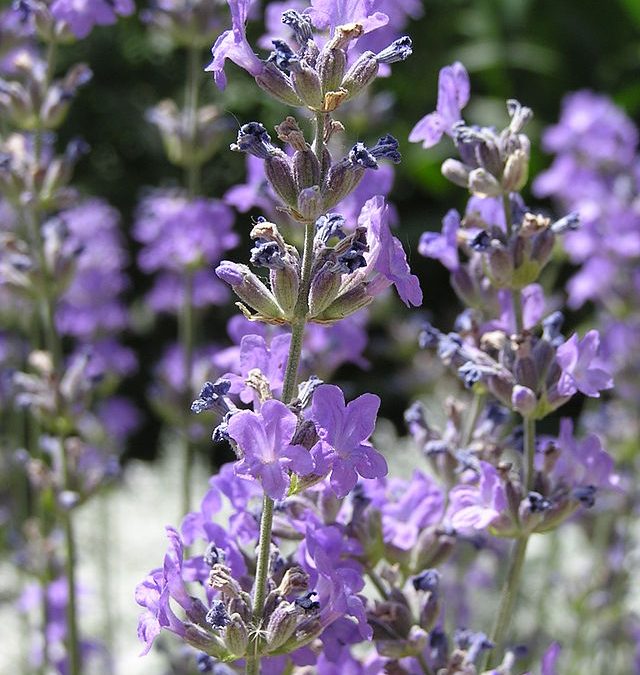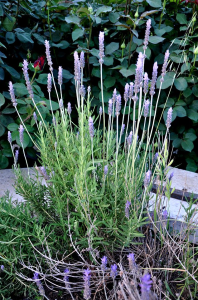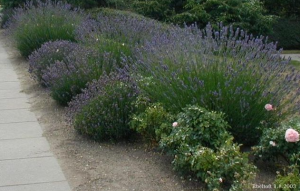Lavandula angustifolia, native to the Mediterranean area, is an aromatic shrub known for its purple flowers. Commonly known as English sage, this evergreen plant is an excellent choice for a variety of landscapes, from water smart planters to English gardens.
English lavender tends to grow from two to three feet tall, and once it’s established (after around a year from planting time) it has very low water requirements.
Lavandula angustifolia with midsummer blooms. Faded flowers can be removed to promote longer blooming periods.
Landscape Planting – Lavandula angustifolia basics
Botanical Name: Lavandula angustifolia
Common Name: Lavender, English lavender, common lavender
Type: Evergreen, perennial, shrub
Native Range: the Mediterranean
Size: 2 – 3 feet tall, 2 – 4 feet wide
Bloom Time: Midsummer
Bloom Description: Purple (light to dark). Some hybrids are violet-blue, white, pink
Sun: Full sun
Water: once established (around one year after planting), water around once to twice a week during dry weather, but you can turn off the irrigation during the rainy season
Maintenance: Prune in spring to help shape the plant, and prune again in early fall
Suggested Use: Border planting, within rock gardens, herb gardens
Mature English lavender used as border planting. These plants can be sheared down to around eight inches every few years or so to keep them a smaller size.
For landscape planting, English lavender grows best in full sun areas. Our landscape designers at Creative Concepts Landscape will be happy to look over your property and determine areas that are optimal for these types of plants.
These plants are also deer resistant, making them a great choice in the foothills where deer damage is more common. It is said that the aroma of English lavender will even repel deer (and cats). This plant is toxic to pets.
Our designers can take a look at your property and see if English lavender’s needs can be met. We create a design plan for all of our consultations to determine what plants and needs match each individual property. English lavender makes an excellent addition to water-wise gardens. Their gray tones with busts of pastel blooms look at home in chaparral themed landscapes, they can be incorporated into many different design types, including more traditional English gardens. Again, Creative Concepts Landscape will help to determine the best location on your property, or create the conditions to promote a healthy, beautiful garden.
Englis lavender has low water requirements, once established, perfect for the drought tolerant garden. In the first year after planting, while your English lavender is establishing itself in the landscape, they will need irrigation systems or regular hand watering. Creative Concepts Landscape has installed many irrigation systems (drip and sprinkler), and we would be happy to take a look at your property to come up with a design that could meet purple sage’s needs. Once these plants are established (usually around one year after planting) the irrigation can be reduced to around once per week, or twice during high temperatures. If there is rain, the irrigation can be turned off completely in late fall through winter.
These plants also prefer well-draining soils. Most of the natural soil in Southern California is somewhat sandy, well-draining soil.
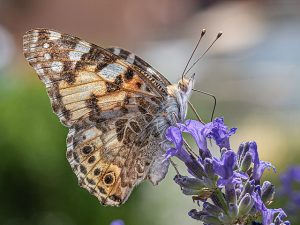
English lavender attracts beneficial pollinators such as butterflies and bees.
Pruning & Maintenance
English lavender is fairly low in maintenance needs. In many cases, providing supplemental water for these plants, while they are becoming established, is the highest maintenance requirement. Creative Concepts Landscape has been installing irrigation systems for over twenty years. We will be happy to schedule a consultation and come up with an irrigation system plan and install it. Creative Concepts landscape also repairs and refurbishes existing irrigation systems, so they are in optimal, efficient condition.
Outside of maintaining an irrigation system for English lavender, the plant can be pruned in early spring to help shape it. Pruning shears should be used to remove all dead and damaged branches. It can be pruned once again, lightly, in early fall to thin and allow for increased air flow, which helps to prevent rot. Every few years, the plant can be sheared down to around eight inches in early spring to help maintain a smaller size and promote new growth. Outside of these periodic shearings, the larger, woody stems should not be cut during routine pruning.
Creative Concepts Landscape has options for maintenance schedules. Many of our clients have us maintain their property weekly or two times a month, however we also offer periodic cleanups. These cleanups range from four times a year, twice a year, and sometimes once a year. We will be happy to talk with you and determine a maintenance/cleanup schedule that fits your property needs.
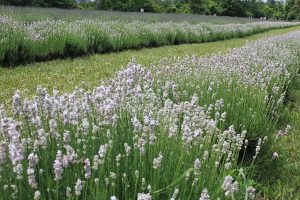
English lavender is best known for deep purple flowers, however certain hybrids have light purple, or even pink, blooms.
Landscape Uses
For landscape planting, English lavender grows well in full sun and is useful as a border plant with eye catching blooms, or as eye catching shrubs within a rock garden. Creative Concepts Landscape gets many requests for water-wise (drought tolerant) garden installations, of which English lavender can be a welcome addition. Our team of designers and technicians has decades of experience designing and installing gardens.
English lavender is known for its pleasant fragrance. It also attracts beneficial pollinators such as butterflies and bees.
Creative Concepts Landscape creates a landscape plan and design for your specific property characteristics along with your wants. Our highly experienced designers will be able to see what plant types and layout will complement your landscape’s existing features to come up with a planting design plan.
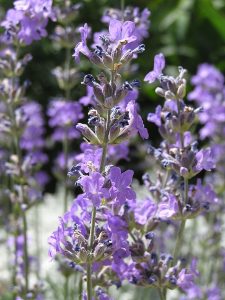
The eye-catching beauty of English lavender
Thank you for joining us again in this week’s horticultural adventures. Please come back next Wednesday for out next blog post, and as always, contact us for all your landscape needs!
By Daniel Williams
Client Liaison for Creative Concepts Landscape

